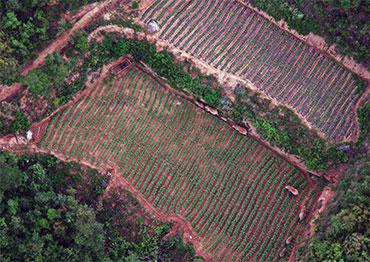Listed as endangered by the International Union for Conservation of Nature, Asian elephants are highly protected in China, where they are mostly concentrated in the tropical forests of Yunnan’s Xishuangbanna and within the city limits of Pu’er and Lincang.
Covering 100,000 hectares, Mengyangzi Nature Reserve is home to about 90 Asian elephants, a subpopulation of several herds, according to Wang Qiaoyan, a senior engineer at the Xishuangbanna National Nature Reserve.
By mid-June, the herd of 15 elephants, which includes six females, three males, three adolescents and three calves, had traveled over 500 kilometers, about halfway across Yunnan Province.
Although Asian elephants do migrate, experts are surprised by the length of the herd’s trek, and have been stumped as to their direction and destination.
Some attributed the migration to deforestation in Xishuangbanna as farmers shifted to cultivating rubber and tea.
“The root cause I think is that the habitat can no longer support the increasing demands of the elephants,” Zhang Li, a field biologist from Beijing Normal University who specializes in Asian elephants and China’s collective forest tenure reform policy, told NewsChina.
According to Zhang, China’s population of Asian elephants grew from 170 in the 1980s to 300 today, while their habitats shrank from a combined 2,084 square kilometers in 1976 to only 500 square kilometers in recent years.
In his 2017 thesis published in academic journal Scientific Reports, Zhang wrote that the number of rubber trees in Xishuangbanna, Lincang and Pu’er had increased 23-fold over the past four decades. Water hungry and with dense canopies, the trees have choked the undergrowth that feeds Asian elephants, Zhang wrote.
Wu Zhaolu, a professor at Yunnan University’s School of Ecology and Environment, supported Zhang’s assessment. “Although the growth of those profitable trees has increased forestation in the area, they eroded the natural forest as well, which has fragmented the animal habitats in Xishuangbanna,” he told NewsChina.
According to Cao Mengliang, former director of the Xishuangbanna forestry and grassland bureau, the local government has encouraged farmers to plant rubber trees since the 1980s to meet State demand. But the real boom came in the 2000s as natural rubber prices skyrocketed, multiplying about six times between 2002 and 2011. Xishuangbanna has 298,000 hectares of cultivated rubber trees on State land and leased farms.
In an interview with news portal guancha.cn, Gu Bojian, an expert at Fudan University’s School of Life Sciences in Shanghai, said the farming of cardamom seeds (also known as sha ren), valued in traditional Chinese medicine, is also to blame, as it requires removing all surrounding undergrowth to give them access to sunlight and nutrition.
This was supported in the 2018 Chinese Traditional Medicine Industry report published by the Xishuangbanna government, which said it owned over 1.9 million mu (126,667 hectares) of cardamom seeds valued at 430.9 million yuan (US$66.5m). In the past, the crop was promoted in poverty alleviation programs for Yunnan’s poorest counties.
Some experts, however, say cash crops in Xishuangbanna are not solely at fault. “Nature reserves were fragmented when they were established [50 years earlier],” Guo Xianming, director of the Science Institute under the Xishuangbanna National Nature Reserve who has studied Asian elephants for three decades, told NewsChina. There are five nature reserves in Xishuangbanna. “It’s like the panda reserves in Sichuan Province. They have many panda reserves, large and small, but nobody describes them as ‘fragmented,’” he added.
Xishuangbanna National Nature Reserve is divided into core areas, buffer zones and experimental areas. According to regulations, logging is strictly prohibited in the former two.
“Asian elephants and their habitats have been under stringent protection and there are feeding points in them. That’s why the population of wild Asian elephants in Yunnan has grown so substantially,” Guo said, adding that local farmers planted trees on land allocated to them by the government and were not in violation of animal and forest protection laws.
Both Guo and Wang Qiaoyan, the senior engineer, believe that the reserves’ successful forestry policies played a part in the herd’s migration. “Elephants will instinctively stamp down young trees of a certain height to prevent them from becoming a forest... As we improve forest protection, the wilderness and secondary forest [where elephants live] decreases annually,” Wang told NewsChina.
Data from Yunnan’s provincial forestry and grassland bureau showed that forest coverage in the Xishuangbanna National Nature Reserve had increased from 88.9 percent in 1983 to 97.02 percent in 2016. This increased canopy density, which is not good for undergrowth. Wang attributed the migration to shrinking habitats and decreased natural food supplies.
Guo Xianming said he is fully aware that the Xinshuangbanna nature reserve’s primary goal was not only to protect Asian elephants but also the entire rainforest ecosystem. “Maybe we should have been a little more innovative and flexible in nature reserves dedicated to protecting Asian elephants,” he said.

 Old Version
Old Version


